Dual-Core LGA1156 Processors: Core i5-661, Core i3-540 and Pentium G6950 CPUs Review

Today Intel is expanding their LGA1156 platform processor lineup by rolling out new dual-core Clarkdale processors manufactured with 32 nm process. The manufacturer has every intention to make them a true sales hit: they will exist in three different families and the prices of different models will lie in the interval between $84 and $284. What are the real marketing prospects of these new solutions and has Nehalem microarchitecture retained all its charm in the dual-core incarnation. These are the questions we will try answering in our today’s article.
Almost all our latest articles dedicated to the new Intel processors start in the same exact way: with a short reminder of the “tick tock” strategy, long-term schedule for further enhancement of this manufacturer’s microarchitecture and production technologies that was in place for the past several years. We are not going to be original this time either. It is true: the desire to stick to the promises is in fact the only reason why Intel keeps rolling out new generation solutions on an annual basis. Starting with 2006 when they first introduced their Core microarchitecture, this company has remained the performance leader in the CPU field. The second move that strengthened Intel’s positions in the processor market dramatically was the introduction of 45 nm manufacturing process a year later, in 2007. You may think that they could have stopped there, but the desire to continue sticking to “tick tock” strategy didn’t let them slow down even a bit. They continued making progress and in 2008 introduced new Nehalem microarchitecture. The launch of Bloomfield and then Lynnfield processors has totally eliminated all doubts that Intel was the only one at the top of the processor market.
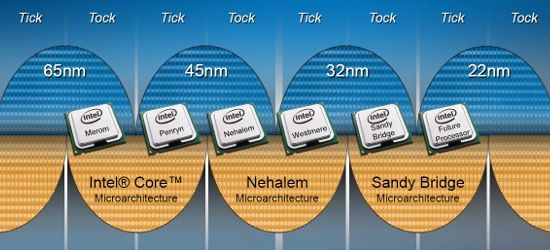
But the story doesn’t end here. The original schedule suggested that 2009 was supposed to be the time for Intel to transition to an even more advanced 32 nm process. And again Intel didn’t veer away from the promises they had made several year ago. Although 2009 is technically already over, the company started making 32 nm processor last year already. So, today these CPU are not just announced but are already widely available in retail. I am talking about a family of solutions known under Westmere codename, which include Gulftown and Clarkdale desktop processors and mobile Arrandale CPUs. Although at this point the company only offers two solutions of the three – Clarkdale and Arrandale, but the fact is undeniable: the new production technology has been introduced in time.
Today we are going to talk about the new 32 nm dual-core Clarkdale processors designed for desktop platforms. It is remarkable that these CPUs are positioned not for the upper price segment, but on the contrary, for the mainstream and value segments. This strategy for introduction of the new manufacturing processor “from the bottom to the top” is indeed the result of adapting Intel’s “tick tock” policy to the current market situation. No doubt that nothing is threatening the well-being of 45 nm Bloomfield and Lynnfield CPUs in the upper price segment. AMD doesn’t have and is not going to have any alternative solutions here for a long time. That is why Intel has no real reason to replace these solutions with anything newer just yet. Therefore, it is not surprising that the high-performance six-core Gulftown processor manufactured with 32 nm process will come out later.
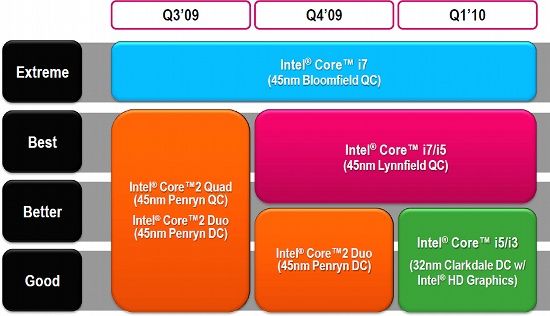
As for the dual-core Clarkdale, it is aimed at a completely different target. Intel is going to use this CPU to strengthen their positions in the mainstream and low-end segments by replacing the morally outdated LGA775 solutions there. It obviously makes a lot of practical sense. First, Core 2 Quad and Core 2 Duo are facing very serious competition from the pretty successful AMD Phenom II and Athlon II processor families. Therefore, it would really help to replace them with something more efficient. Second, the refresh of the mainstream platform should definitely stimulate chipset and mainboard sales, especially since we are going through mass transition to the new Windows 7 operating system at this time.
So, Intel is going to turn Clarkdale into one of the best-selling processors in the market. Therefore, they pin a lot of hopes upon this inexpensive CPU: it should boast more advanced consumer qualities than its predecessors as well as competitors. But will it prove up to everyone’s expectations? This is the question we are going to answer in our today’s review.
LGA1156 Platform Evolution
Clarkdale processors that come to replace Core 2 family solutions send the entire LGA775 platform to the garbage heap of history. Being the bearer of Nehalem microarchitecture, Clarkdale doesn’t use FSB processor bus, but has a built-in North bridge like Bloomfield and Lynnfield. Intel decided not to introduce a new processor socket form-factor for Clarkdale and designed it compatible with LGA1156 platform, which obviously turns into a practically universal solution at this point. As a result, Clarkdale, just like the previously launched LGA1156 Lynnfield CPUs, has the same set of functional units (computational cores, L3 cache, memory controller, PCI Express controller) and employs DMI bus to connect to the chipset South Bridge.
In fact, Intel winds up the evolution of their platforms by launching the new Clarkdale today. As a result of this evolution, the chipset has completely lost its traditional role: North Bridge has become a part of the CPU and there is only one chip left from the chipset – the South Bridge, which is responsible for interfaces for external devices. Therefore, any contemporary system now consists of only two primary chips instead of three.
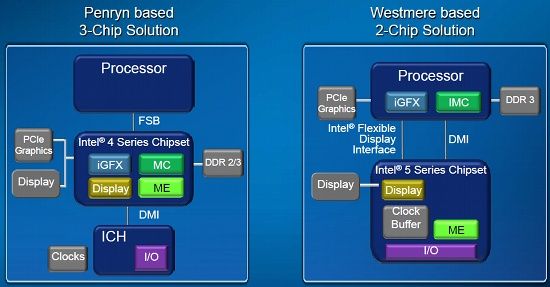
When Intel developers were making sure that Clarkdale complied with the new platform building principles, they had to take another revolutionary step. The thing is that since Clarkdale is targeted for the mainstream and low-end segments, there must be a platform option that would use an integrated graphics core. As you remember, graphics cores used to be integrated into the chipset North Bridge before, but it no longer exists as an independent functional unit. As a result, the graphics core followed in the footsteps of the memory and PCI Express bus controller and also moved into the processor. So, Clarkdale became one of the first desktop CPUs featuring not only computational units but also a GPU.
I have to say that although Clarkdale has an integrated graphics core, it doesn’t have to be used in all systems. The CPU also features a PCI Express x16 graphics bus controller, which means that Clarkdale based systems can also take on discrete graphics cards. In this case the integrated GPU will be disabled. The systems built on mobile Clarkdale modifications called Arrandale will also offer some choices when it comes to interaction between the graphics core integrated into the processor and the add-on graphics card. For example, you will be able to switch between the internal and external graphics core without rebooting the system. However, desktop platforms won’t support this function.
You must use special chipsets for Clarkdale processor to be able to employ the integrated graphics core. They are called Intel H55 Express, Intel H57 Express and Intel Q57 Express. The primary difference between them and the already existing Intel P55 Express LGA1156 chipset is in the special digital interface aka Intel FDI (Flexible Display Interface). It is intended for transferring the video signal from the processor through LGA1156 socket outside to HDMI, DVI or D-Sub mainboard outputs. However, it is implemented in a very simple manner: FDI bus uses DisplayPort and chipsets supporting integrated graphics have a small controller in their South Bridge that provides routing and digital-analogue conversion of the video signal.
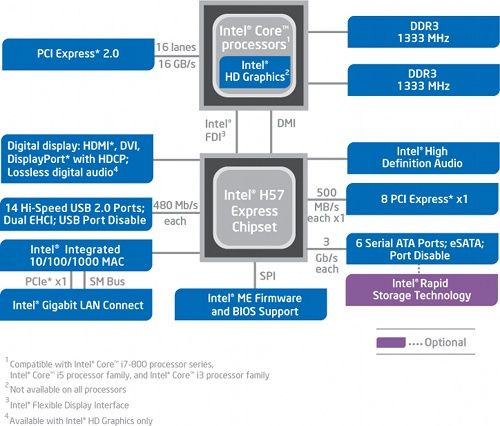
As a result, different LGA1156 processors and mainboards appear mutually compatible, despite obvious differences between them. Clarkdale processors can work with an external graphics accelerator in any LGA1156 mainboards based on the old Intel P55 Express as well as the new Intel H55, H57 and Q57 chipsets. However, if you intend to use the integrated graphics core, you can only go with solutions on Intel H55, H57 and Q57 chipsets supporting FDI and featuring “monitor” outs on the connector panel. BY the way, the existing Lynnfield processors are also compatible with these new boards built around Intel H55, H57 and Q57 chipsets, but you will have to use an external graphics card, because these processors have no integrated GPU.
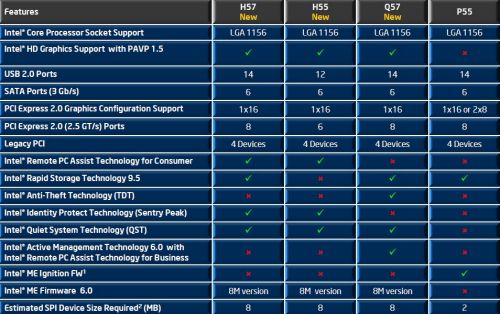
The ability to use the integrated graphics core in the CPU is not the only difference between the LGA1156 chipsets. Intel P55 solution that doesn’t support FDI bus is the only chipset that allows using a pair of graphics cards connected as PCI Express 8x + 8x. Intel H55 targeted for entry-level systems doesn’t support RAID and features 12 USB 2.0 ports instead of 14 alongside with fewer PCI Express lanes for peripheral devices. The Q57 chipset targeted for corporate systems supports Intel AMT remote system management technology. Intel H57 is the most feature-rich modification supporting integrated GPU.
Closer Look at Clarkdale Processor
Trying to expand the application field for LGA1156 platform, which so far has only had pretty expensive quad-core solutions in its arsenal, Intel intended Clarkdale to become an inexpensive dual-core solution. However, since it features an integrated graphics core, it becomes almost as complex internally as quad-core Lynnfield processors. And it means that despite the use of new 32 nm manufacturing process, Clarkdale processors production costs can easily become so high that it would make absolutely no sense for the manufacturer to promote these solutions in the low-end market segment.
Therefore, trying to lower the production costs of the new CPU, Intel suggested a unique design based not on a single monolithic semiconductor die of a comparatively large size, but on two relatively small dies put into a single CPU packaging. These two dies have separate functionality. The first die of about 78 mm2 is the actual dual-core processor, while the second 38 mm2 larger die is the GPU. However, even with this pretty natural distribution of responsibilities Clarkdale offers quite a few very interesting design concepts. The thing is that this implementation of the processor die features only two computational cores and an L3 cache. All North Bridge components, including the memory controller and PCI Express bus controller found their place in the GPU die.
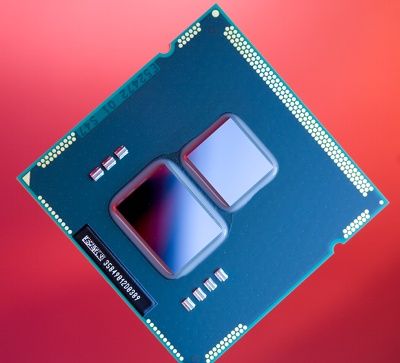
We ended up with a very interesting picture: although Intel claims that they have combined the processor with the chipset North Bridge, if we dig a little deeper LGA1156 systems with Clarkdale processors look structurally the same as the previous generation platforms. The North Bridge is still there, it even exists as an individual semiconductor die. The only difference is that now this die doesn’t have its own packaging and is hidden inside the CPU case. Nevertheless, the FSB bus has really sunk into oblivion. Instead there is high-speed QPI interface used to connect the processor die and the North Bridge die within single packaging.
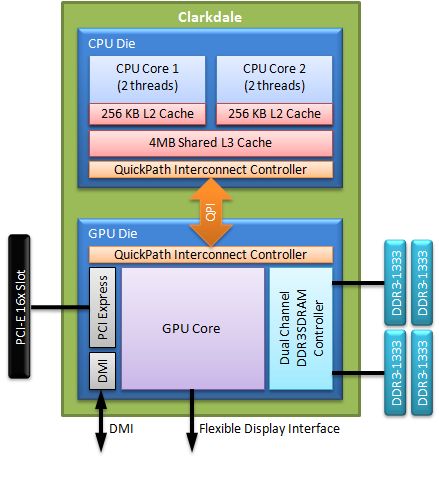
In fact, the processor die is manufactured using new 32 nm process. There are no special innovations in this manufacturing process: it produces transistors using high-k dielectric and metal gates like the ones in Intel’s 45 nm semiconductor dies. However, even by simply making these transistors smaller, Intel could speed up their switching, lower their heat dissipation and reduce the overall die size, which totally justifies the introduction of the new manufacturing process and use of immersion lithography equipment in Intel’s fabs. Clarkdale features a die of the same size as Wolfdale-3M used in Core 2 Duo E7000 CPUs, but the 32 nm processor has more cache memory. However, it wouldn’t be totally correct to call Clarkdale a fully 32 nm CPU. The thing is that the second semiconductor die containing the GPU and North Bridge is manufactured with 45 nm technological process.
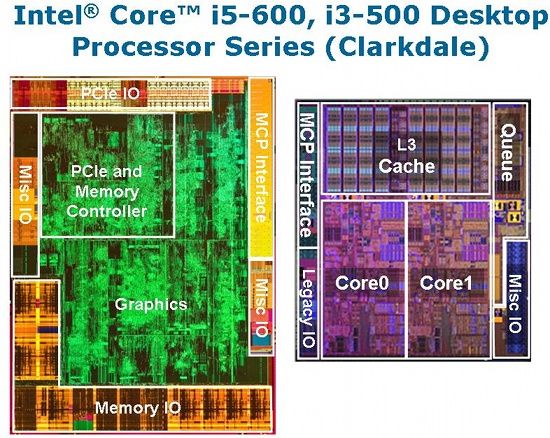
The processor die contains two cores with Nehalem microarchitecture supporting Hyper-Threading technology. Therefore, although Clarkdale is a dual-core CPU, the operating system sees it as having four cores. And this particular fact allows Intel to position top Clarkdale models also as alternatives to quad-core LGA775 processors. L3 cache memory, which is also located inside the 32 nm processor die, is 4 MB big. So, compared with Lynnfield, Clarkdale has not only half the cores, but also half the L3 cache memory.
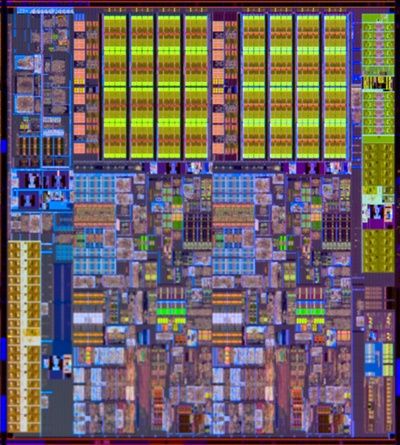
Most of the die is occupied by the graphics core, which represents the next generation of the Intel GMA. Compared with GMA X4500 built into Intel G45 LGA775 chipsets, the new graphics core has 12 shader processors instead of 10, works at slightly higher frequency and can use more memory for its needs. Nevertheless, its general performance level is still that of an integrated solution, so Clarkdale has no intention to become an alternative to discrete graphics cards.
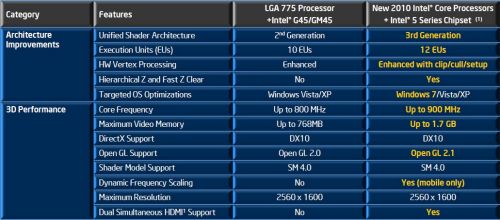
The second die holds not only the graphics core but also a dual-channel memory controller supporting DDR3 SDRAM. I have to say that unlike the memory controller in Lynnfield processors, the one in Clarkdale supports only DDR3-1067 and DDR3-1333 memory, but in nominal mode when the CPU is not overclocked it can’t work with DDR3-1600. Moreover, the actual performance of the memory subsystem on Clarkdale based platforms will also be a little lower because the memory controller and the processor are located in two physically different semiconductor dies connected via the internal QPI bus.
Another important functional knot located in the North Bridge semiconductor die is the graphics bus controller. It uses PCI Express 2.0 protocol and supports 16 lanes that can be combined into a single PCI Express x16 bus or split into two PCI Express x8 busses. However, this split is only possible when the CPU is installed in an Intel P55 based mainboard.
Clarkdale Modifications
As you remember, Lynnfield processors found their way into two processor families: Core i7 and Core i5. Clarkdale CPUs, however, will exist in three incarnations: Core i5, Core i3 and Pentium. And it means not only that Clarkdale retail price will vary in very broad intervals, but also that Intel will offer different Clarkdale modifications with more than just different clock frequencies. To differentiate between multiple Clarkdale families they will also take into account disabling of Hyper-Threading and Turbo Boost technologies and manipulating the cache-memory size. As a result, there will be five different Intel processors for LGA1156 platform including Lynnfield models. We summed up their basic specifications in the table below:
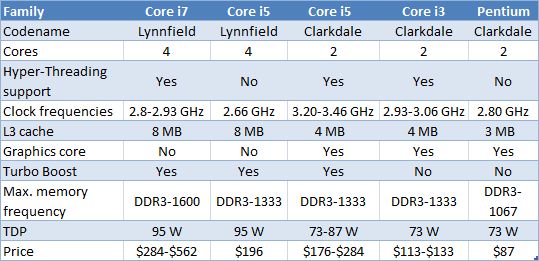
Note that top Clarkdale processors from Core i5 family are targeted at about the same market niche as junior Lynnfield CPUs. Intel obviously has very high expectations of their new dual-core processors, believing that their high clock frequencies and Hyper-Threading technology support will help them compete successfully against quad-core processors.
There will be a total of seven different Clarkdale models available in the market:
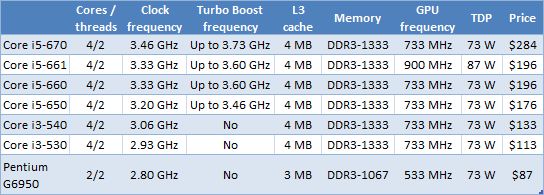
Core i5-600 processors represent the most feature-rich Clarkdale version. They support Turbo Boost and Hyper-Threading technology and their nominal clock frequencies surpass the frequencies of quad-core Core i7 CPUs even with a working Turbo Boost technology. Moreover, there are two top models in the Core i5 family: Core i5-670 with maximum clock frequency of 3.46 GHz and Core i5-661 working at 3.33 GHz and graphics core overclocked to 900 MHz – the highest frequency among all other available models.
Core i3-500 processors do not support Turbo Boost technology that is why they can fall seriously behind Core i5 during single-threaded load although they work at very similar nominal frequencies. However, Hyper-Threading support is still in place that is why these processors can also be considered a suitable alternative to inexpensive quad-core solutions, just like Core i5-600.
The Pentium processor has the most modest feature list of all. This CPU doesn’t support Turbo Boost and Hyper-Threading that is why the operating system sees it only as a dual-core processor. Moreover, this inexpensive processor has a graphics core working at a lower frequency and doesn’t support DDR3-1333 SDRAM. In other words, it is a typical budget solution with all sorts of “delicacies” blocked right from the start. Besides, L3 cache in Pentium processors has been reduced to 3 MB.
I have to say that Intel decided not to make Turbo Boost technology in Clarkdale processors as aggressive as in Lynnfield CPUs. All new Core i5-600 processors supporting this technology can increase their clock frequency by one increment in case both cores are loaded and by two increments in case of single-threaded load. It means that maximum frequency increase for Clarkdale processors is only 266 MHz. Lynnfield CPUs, however, can increase their frequency by 4-5 increments, i.e. the total increase my reach 667 MHz. This introduces certain adjustments into the correlation between the clock frequencies of dual- and quad-core processors: under partial load the performance difference between Lynnfield and Clarkdale processors may get lower. The table below shows the frequencies of Core i7 and Core i5 LGA1156 processors supporting Turbo Boost under different type of operational load:
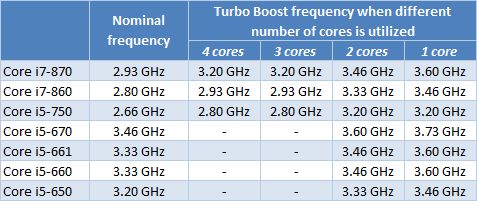
While in LGA775 systems dual-core processors were often faster than quad-core ones due to their higher clock frequency, in LGA1156 systems we will see the same situation less frequently. Due to Turbo Boost support, quad-core Lynnfield CPUs will be overclocked automatically when the load becomes less intense and only one or two cores are actually busy. This way their clock frequency will get close to that of dual-core processors. Therefore, similar price of Core i5-670 and Core i7-860 shouldn’t mislead you: it is justified not that much by the computational performance of the top Clarkdale CPUs, but mostly by broader functionality due to integrated graphics core.
Weak Link: Clarkdale Memory Controller
Dual-die structure of the new Clarkdale processor is very interesting and quite justified. By distributing the functionality of a highly-integrated processing unit between two semiconductor dies put into the same packaging Intel engineers ended up with a solution that was inexpensive to make and suitable not only for the mainstream but also for the low-end segment. However, this lowering of the price point may produce some serious technical issues. In Clarkdale’s case we are mostly concerned with the fact that its integrated memory controller became not so integrated after all, which may affect the work of this CPU with the memory.
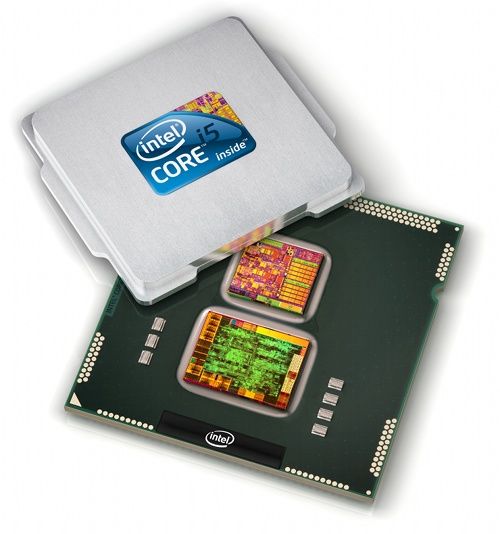
Although the memory controller is inside the processor packaging it doesn’t put it any closer to the CPU cores. In Clarkdale it is singled out into a separate semiconductor die together with the GPU. It is certainly great for improving the performance of the integrated graphics core that can use fast memory access, but at the same time the memory controller is separated from the computational cores. As a result, processor cores work with the memory not directly, but via QPI bus that connects the CPU and GPU dies within Clarkdale packaging.
What does it mean in practical terms? For our initial checkup we decided to use synthetic benchmarks to compare the performance of the memory subsystem in Core i5 LGA1156 processors from Lynnfield and Clarkdale families. The memory controller in the first processor is located inside the same die as the processor computational cores, that is why it doesn’t require any intermediate busses to work with the memory. The second processor has a “remote” memory controller that requires a pretty long chain including the following knots: core – QPI controller – QPI bus – QPI controller – memory controller. During the test both processors were launched at the same frequency of 2.8 GHz. The memory in both cases worked as DDR3-1333 SDRAM with 9-9-9-27 timings.
The first benchmark we used was Cachemem from the diagnostic Everest Ultimate 5.30 utility.
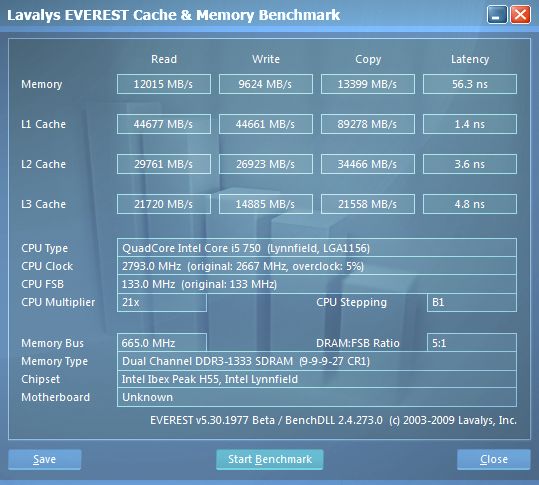
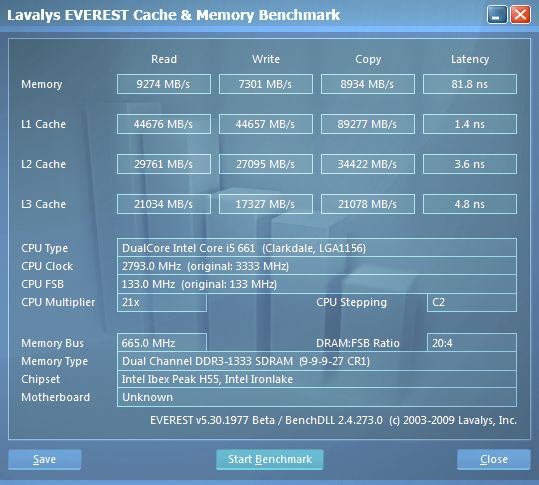
The results turned out quite sad to put it mildly. Clarkdale loses about 25% to Lynnfield in practical memory subsystem bandwidth. Things look even worse for the new processor in terms of latency: the difference reaches 45%. Unfortunately, we seem to be paying too high of a price for lowering the processor production costs by separating the key functional units in two different semiconductor dies.
We arrive at the same sad conclusion after running the tests in another utility that measures the practical parameters of the memory subsystem – MaxxMem. And that is still the case even though we picked the junior Lynnfield processor, Core i5-750, to compare against Clarkdale, as it has the slowest memory controller working at 2.13 GHz instead of 2.4 GHz.
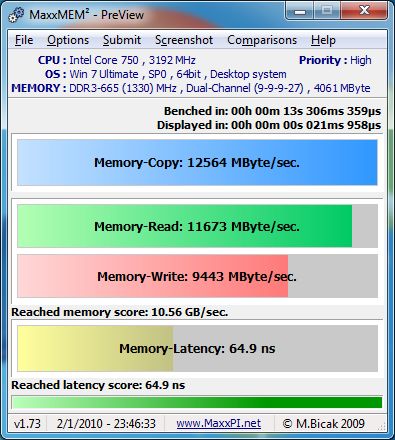
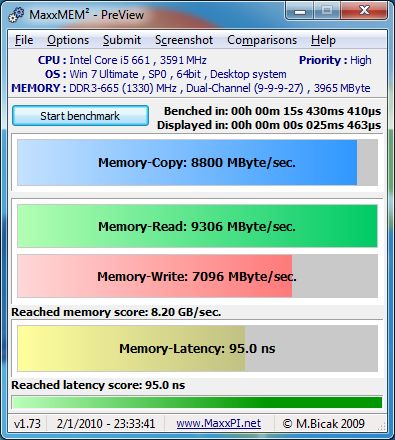
I have to say that the pseudo-integrated memory controller inside Clarkdale processor proved so slow that its performance could be compared to that of the controller in LGA775 systems using FSB bus to connect it with the CPU. Look, for instance, at the Cachemem results taken off the LGA775 system using DDR3-1333 SDRAM with 9-9-9-27 timings and built with Intel P45 chipset and Core 2 Quad Q9550 processor.
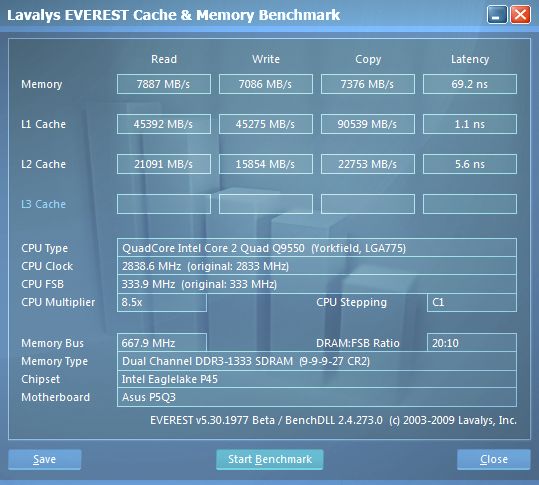
The memory sub-system in LGA775 platform demonstrates even lower latency than the memory in Clarkdale based one! So, the idea to separate the processor cores and the memory controller in two different dies even located inside the same packaging resulted in very negative consequences for the memory subsystem performance. It has eventually dropped to the level we saw in systems with outdated structure (when the North Bridge was a separate chip).
The above described problems are also aggravated by the fact that Clarkdale’s memory controller reacts a little strange to the use of lower memory timings. We failed to set CAS Latency to 7 on any of the three LGA1156 mainboards from Intel, Gigabyte and Asus built around H55 and P55 chipsets. When we selected the corresponding option in the BIOS Setup, nothing happened and the system still worked with CAS Latency 8 or 9. I hope that this isn’t a global restriction imposed by the Clarkdale memory controller, but simply a local issue that should eventually be fixed in new BIOS versions and mainboard revisions.
In this respect it is a little comforting that Clarkdale processors still have enough L3 cache memory. Even though it is only half the size of what Lynnfield CPUs have, it is in the same die as the computational cores. Therefore, if we go back to the results of Cachemem test, we will notice that it works not any slower than in Lynnfield demonstrating at even higher write speed.
Something New: Cryptography Support
The developers barely made any micro architectural changes to the cores of the new Clarkdale processors compared against those of Lynnfield. In fact, this is the essence of the “tick tock” concept: if the manufacturing process is improved the microarchitecture remained untouched. But nevertheless, Intel couldn’t help it and added one small but important detail to their new Clarkdale CPU. This processor supports a few new instructions – AESNI set. This set includes six new instructions that accelerate the work of cryptographic AES algorithm, which is one of the most widely spread algorithm for block encryption used by numerous applications.
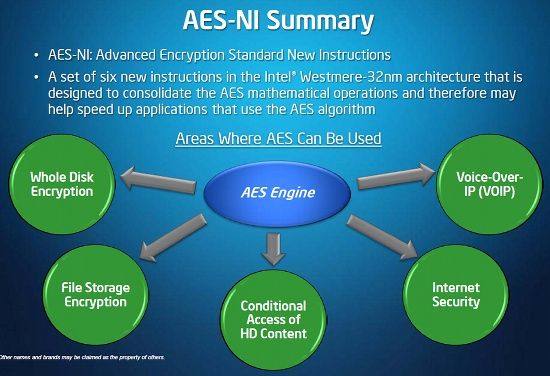
Here it is important to keep in mind that AESNI support is not activated in all Clarkdale processors, but only in those modifications that belong to the “top” Core i5-600 series. Core i3 and Pentium processors do not have any hardware support for cryptographic algorithms yet. This gives us the opportunity to estimate the encryption speed improvement on processors with AESNI support.
For example, we resorted to Sandra utility featuring a cryptographic benchmark to get an idea of AESNI operation. We checked out the results in an LGA1156 platform with Core i3 and Core i5 processors working at the same clock frequency of 3.06 GHz.
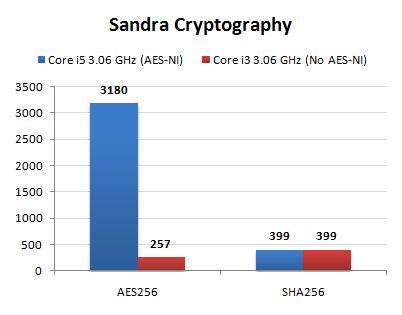
As we see, the CPU with AESNI support performs encryption an order faster than its counterpart without this support. But as you can clearly notice, this effect only takes place during AES encryption. Another cryptographic test measuring the hashing speed using SHA256 algorithm is performed equally fast on both processors, which is quite logical since the instructions from the AESNI set are utilitarian and can only be used during AES algorithm utilization.
Introduction of AESNI instructions support is dramatically different from the traditionally painful adoption of every new SSE extension. Things are absolutely the opposite this time because new instructions are supported not only in specifically optimized synthetic tests. The AESNI set is very up-to-date that is why many popular application developers have already implemented it in their solutions. For example, it already exists in some archiving tools that not only compress data but also encrypt them. As an example of a program like that Intel recommends WinZIP, which 14th version uses AESNI, but we decided to check how the new instructions are supported using another freeware archiving application 7-zip 9.10.
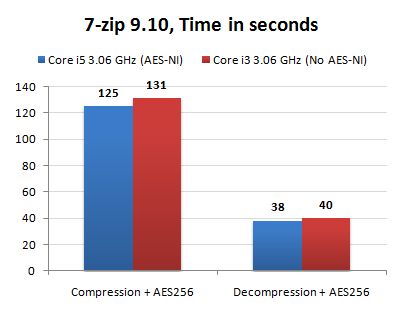
We do see some acceleration, but it is not as impressive as in the synthetic test. In fact it is absolutely correct: against the background of other algorithms that compress the data, the gain from fast encryption gets a little lost. However, we can’t deny that it is indeed there.
Another pleasing fact is that AESNI is also available in Windows 7. All programs using standard functions from the Cryptography API: Next Generation (CNG) included with this operating system will enjoy higher performance on Clarkdale processors supporting the new instructions set without any modifications necessary. For example, take the relatively old PCMark Vantage test, namely the Communication pattern, which uses CNG functions for encryption and decryption algorithms.
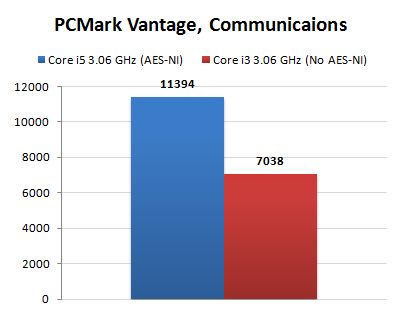
As a result, we see that despite the absence of obvious AESNI support in PCMark Vantage, it runs way faster on a system with a CPU supporting this instruction set.
Testbed Configuration
To test different types of Clarkdale processors we took a sample for each type of this dual-core CPU:
- Core i5-661 with the nominal clock speed of 3.33 GHz, Hyper-Threading and Turbo Boost support, which increase the clock frequency of this processor to 3.46 GHz or 3.6 GHz under different types of workload.
- Core i3-540 with the nominal frequency of 3.06 GHz and Hyper-Threading support. This CPU doesn’t support Turbo Boost.
- Pentium G6950 with the nominal frequency of 2.8 GHz. This processor belongs to the low-end segment that is why it not only has no Hyper-Threading and Turbo Boost support, but also features smaller 3 MB L3 cache.
- CPUs:
- AMD Phenom II X4 965 (Deneb, 3.4 GHz, 4 x 512 KB L2, 6 MB L3);
- AMD Phenom II X4 925 (Deneb, 2.8 GHz, 4 x 512 KB L2, 6 MB L3);
- AMD Athlon II X4 630 (Propus, 2.8 GHz, 4 x 512 KB L2);
- AMD Athlon II X3 435 (Rana, 2.9 GHz, 3 x 512 KB L2);
- AMD Phenom II X2 550 (Callisto, 3.1 GHz, 2 x 512 KB L2, 6 MB L3);
- Intel Core 2 Quad Q9550 (Yorkfield, 2.83 GHz, 1333 MHz FSB, 2 x 6 MB L2);
- Intel Core 2 Quad Q9400 (Yorkfield, 2.66 GHz, 1333 MHz FSB, 2 x 3 MB L2);
- Intel Core 2 Quad Q8400 (Yorkfield, 2.66 GHz, 1333 MHz FSB, 2 x 2 MB L2);
- Intel Core 2 Duo E8500 (Wolfdale, 3.16 GHz, 1333 MHz FSB, 6 MB L2);
- Intel Core 2 Duo E7600 (Wolfdale-3M, 3.06 GHz, 1067 MHz FSB, 3 MB L2);
- Intel Pentium E6500 (Wolfdale-2M, 2.93 GHz, 1067 MHz FSB, 2 MB L2);
- Intel Core i7-860 (Lynnfield, 2.8 GHz, 4 x 256 KB L2, 8 MB L3);
- Intel Core i5-750 (Lynnfield, 2.66 GHz, 4 x 256 KB L2, 8 MB L3); Intel Core i5-661 (Clarkdale, 3.33 GHz, 2 x 256 KB L2, 4 MB L3);
- Intel Core i3-540 (Clarkdale, 3.06 GHz, 2 x 256 KB L2, 4 MB L3);
- Intel Pentium G6950 (Clarkdale, 2.8 GHz, 2 x 256 KB L2, 3 MB L3).
- Mainboards:
- ASUS P5Q3 (LGA775, Intel P45, DDR3 SDRAM);
- ASUS P7P55D Premium (LGA1156, Intel P55 Express);
- Gigabyte MA790FXT-UD5P (Socket AM3, AMD 790FX + SB750, DDR3 SDRAM).
- Memory:
- 2 x 2 GB, DDR3-1600 SDRAM, 8-8-8-24 (Kingston KHX1600C8D3K2/4GX);
- 2 x 2 GB, DDR3-1333 SDRAM, 7-7-7-20 (Mushkin 996601).
- Graphics card: ATI Radeon HD 5870*.
- HDD: Western Digital VelociRaptor WD3000HLFS.
- PSU: Tagan TG880-U33II (880 W).
- OS: Microsoft Windows 7 Ultimate x64.
- Drivers:
- Intel Chipset Driver 9.1.1.1020;
- ATI Catalyst 9.12 Display Driver.
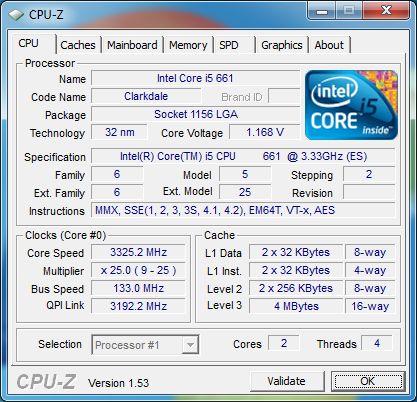
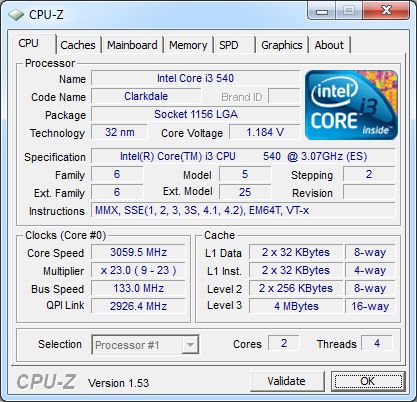
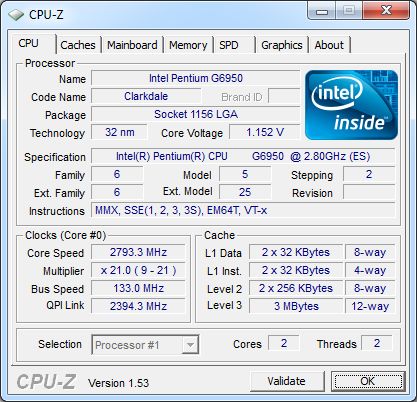
We are going to compare these three new processors against several current typical solutions with two, three and four cores for LGA1156, LGA775 and Socket AM3 systems that belong to the mainstream segment and from the price point prospective can compete against Core i5, Core i3 and Pentium G series CPUs.
The list below shows all the hardware components that were used during our test session:
As you can notice from the list of used testbed components, we didn’t use any mainboards that would allow us to use the graphics adapter integrated into new Clarkdale processors. Today we are going to leave out the discussion of its performance. But very soon we will offer you an in-depth article devoted to performance comparison between the Clarkdale integrated graphics core and integrated chipsets for LGA775 and Socket AM3 platforms.
* – We would like to thank AMD Russia for providing us with ATI Radeon HD 5870 graphics card for this testbed.
Performance
General Performance
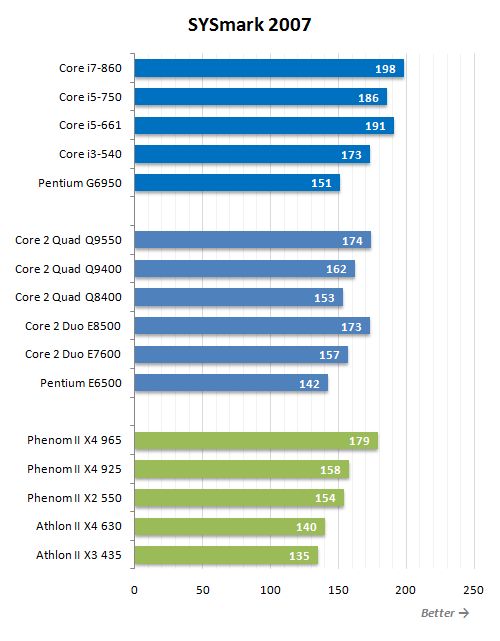
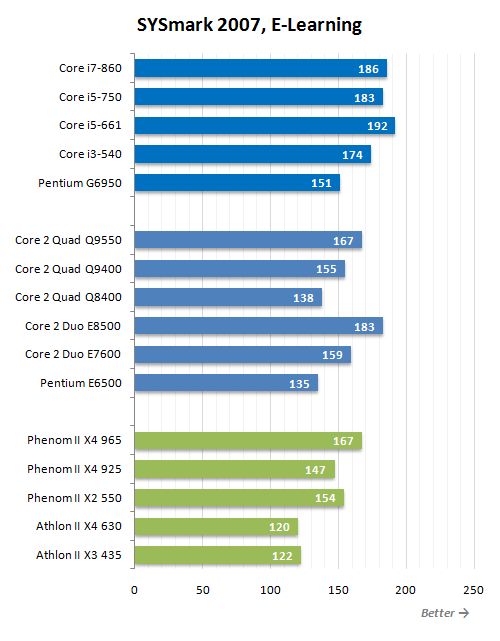
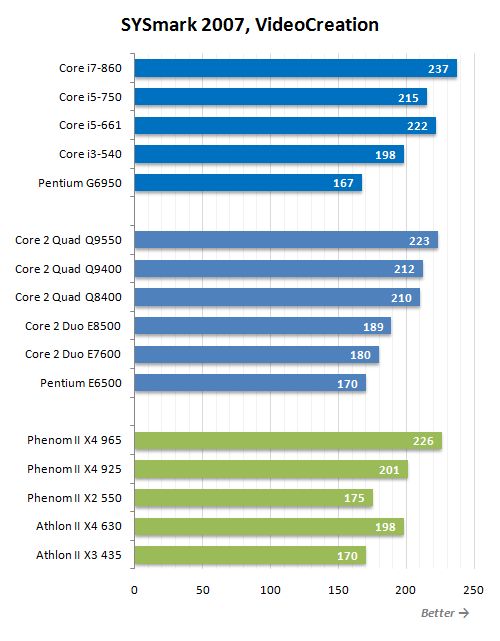
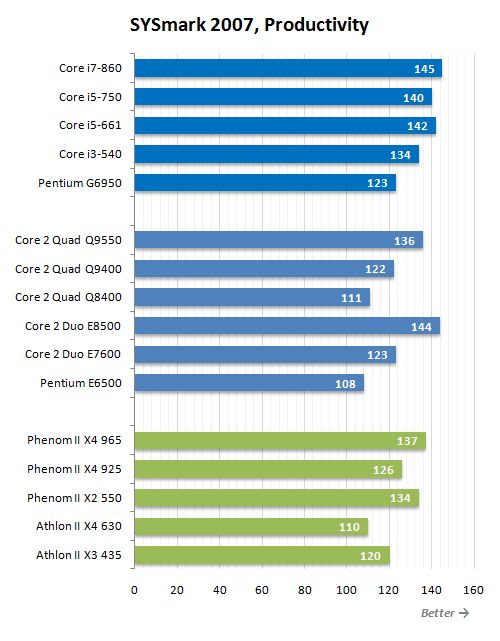
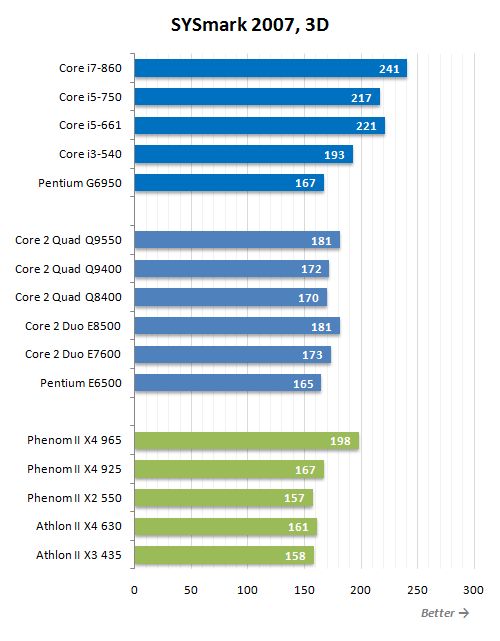
Overall, the general impression from our first encounter with the new Clarkdale processors is highly positive. It is mostly based on the fact that even though the new CPUs are formally dual-core ones, Hyper-Threading technology support makes them work almost as quad-core ones. The top Clarkdale model participating in our test, Core i5-661, looks impressive of all in this case. Almost in all test scenarios it is not only faster than the top solutions in the Core 2 Quad and Phenom II X4 series, but also outperforms the junior Lynnfield modification – Core i5-750. It looks like a combination of high clock frequency and two cores with Hyper-Threading support turns out to be a pretty powerful cocktail.
The performance of Core i3-540 also looks pretty good. In all scenarios except video creation and processing it also outperforms quad-core Core 2 Quad and Phenom II X4 processors and is definitely faster than any dual- and triple-core CPUs available in the market.
Unfortunately, the brilliant performance of the new Core i5 and Core i3 do not inspire Pentium G6950 to do the same. It is actually not surprising, as this processor doesn’t have one of the Clarkdale’s strongest trumps – Hyper-Threading support. As a result, its performance is as high as that of other dual-core Core 2 Duo solutions. In other words, if we were to base our conclusions on the results of SYSmark 2007 test, then Pentium G6950 would be considered a pretty decent replacement to old Pentium E series solutions, but unlike other Clarkdale processors it wouldn’t offer any revolutionary performance boost.
Gaming Performance
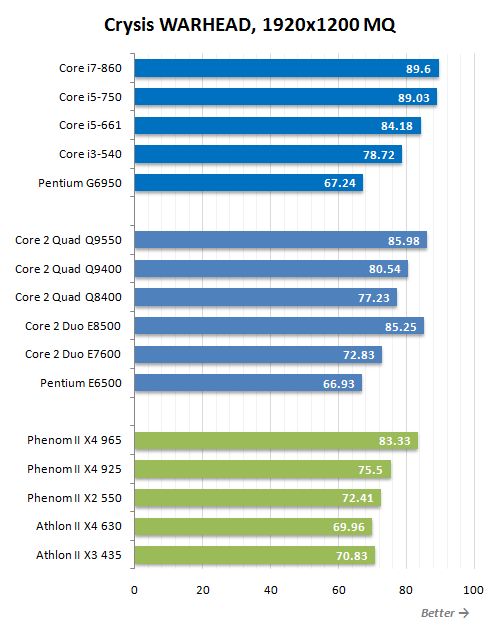
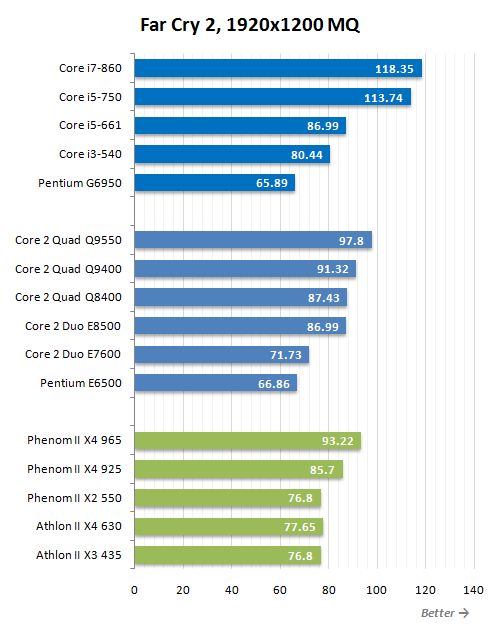
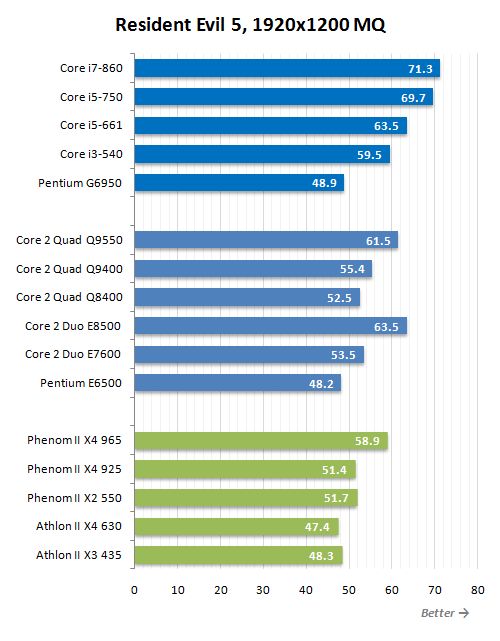
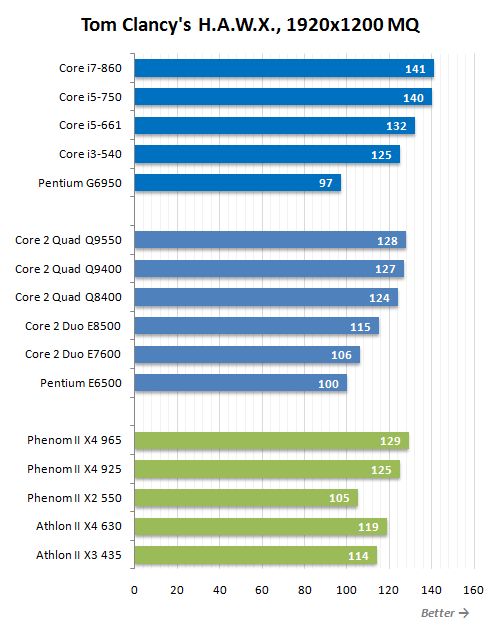
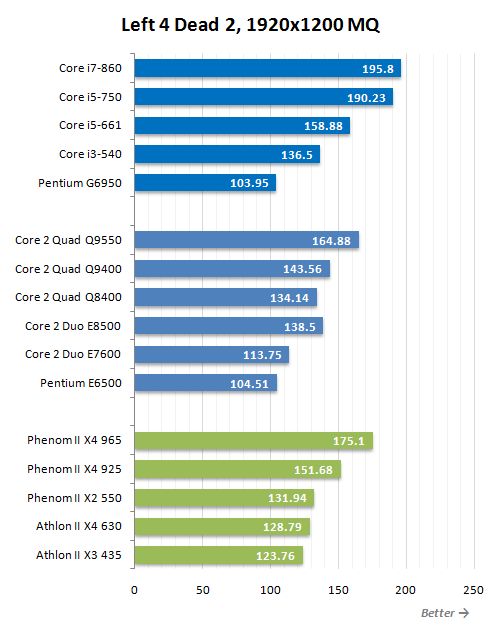
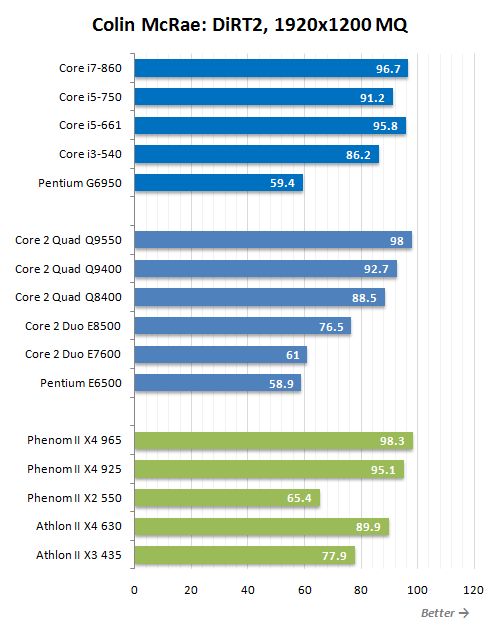
The situation in games is slightly different from what we have just observed in SYSmark 2007, because the generations of gaming applications get replaced and updated way faster than the general purpose suites versions. As a result, games acquire support for new technologies way faster that is why most contemporary 3D games can use the resources offered by multi-core processors quite effectively already. Therefore, in games quad-core Lynnfield CPUs outperform Clarkdale processors with smaller L3 cache and relatively slow memory controller. However, it doesn’t prevent dual-core newcomers from running neck and neck with LGA775 and Socket AM3 solutions as well as frequently outperforming them.
Overall, dual-core Core i5 and Core i3 CPUs are a pretty good solution for a mainstream gaming platform. You can easily build configurations with the new Core i5-600 processors that would run as fast as systems with quad-core Core 2 Quad and Phenom II X4 and would yield in performance only to more expensive systems with top Core i7 solutions.
Core i3 series can also star in its price range: this CPU performed in our tests as good as the top Core 2 Duo CPUs, which makes it a worthy alternative to the junior Phenom II X4 and Core 2 Quad.
The only disappointment is probably the performance of the new Pentium G6950. It is often even slower than the LGA775 Pentium E6500 processor. I have the feeling that Intel engineers may have stripped this CPU of way too many features.
Sound Processing
In this section we are going to discuss the results of two tests: conversion of an audio file set into mp3 format in iTunes 9 and final mixing of a musical track in a popular software mixer Acoustica Mixcraft.
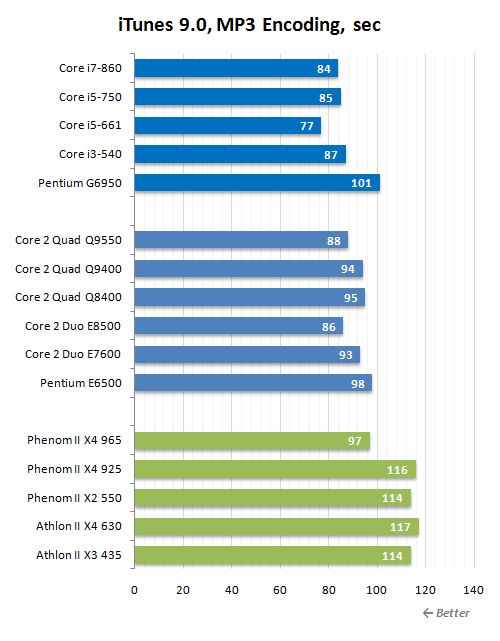
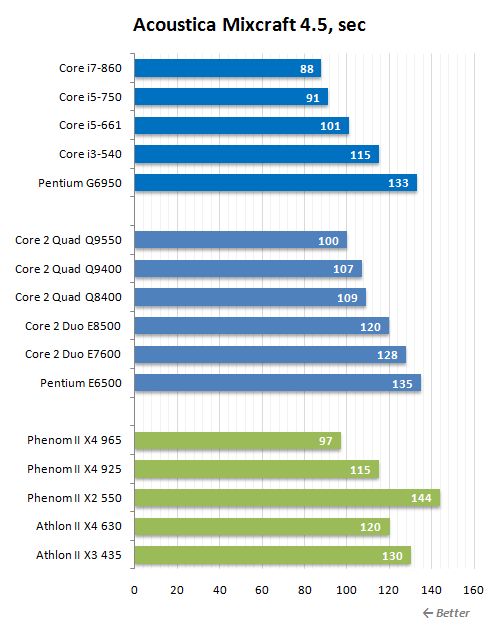
The new 9th version of the iTunes program is still only optimized for dual-core processors. That is why they performed so well in this test: new Core i5-661 and Core i3-540 show nearly the best results among all testing participants.
As for the results of Acoustica Mixcraft, Clarkdale processors suddenly faced serious opposition from AMD solutions, which offered better processing speed in corresponding price range. However, if we compare the results of LGA1156 and LGA775 processors, the picture will remain quite common: Core i5 can be regarded as a fully fledged replacement for Core 2 Quad, and Core i3 offers better performance than Core 2 Duo.
Video Processing
To test the processors performance during work with video content we used three tests: transcoding of an HD MPEG-2 video into H.264 format using x264 codec, transcoding of an HD MPEG-2 video for viewing on Apple iPhone using Cyberlink MediaShow 5 and exporting of a video clip into H.264 Blu-ray format in Adobe Premiere Pro CS4 video editor.
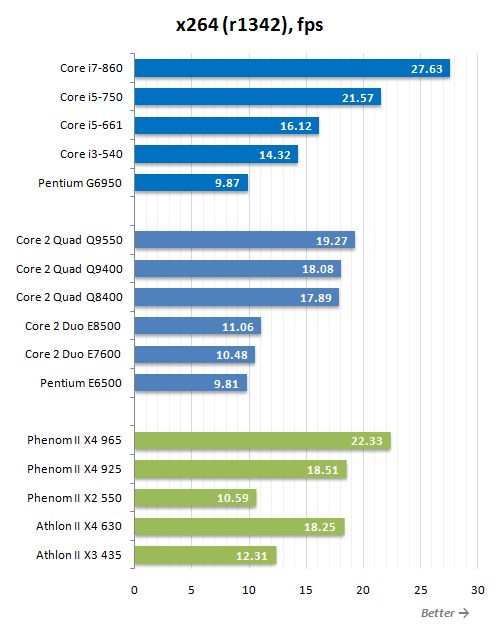
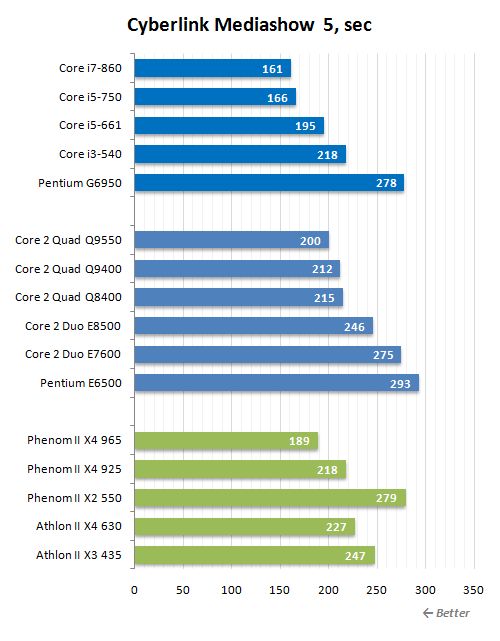
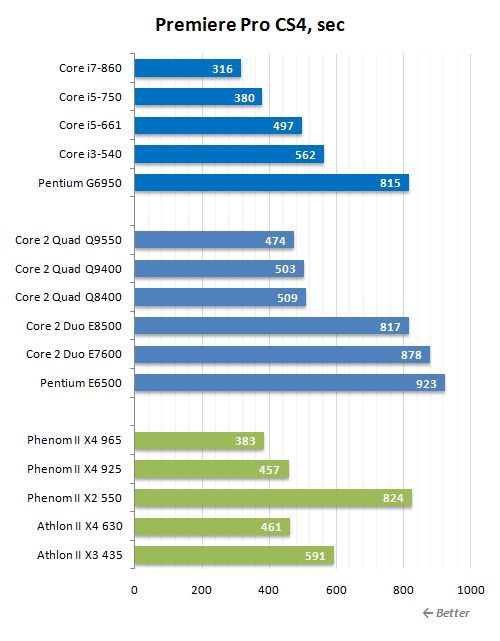
These three different applications for video content creation and processing have one thing in common: they are all well optimized for multi-threading. Therefore, the more cores (preferably real, rather than virtual ones created by Hyper-Threading technology) there are, the better. That is why in these tests Core i5 and Core i3 from the new Clarkdale family lose to the “real” quad-core Phenom II X4 and Core 2 Quad. However, it is due to Hyper-Threading technology that these processors indisputable defeat not only the dual-core Core 2 Duo and Phenom II X2, but even a triple-core Athlon II X3. Pentium G6950 without Hyper-Threading support performs pretty weakly here, even though it is also a Clarkdale.
Final Rendering
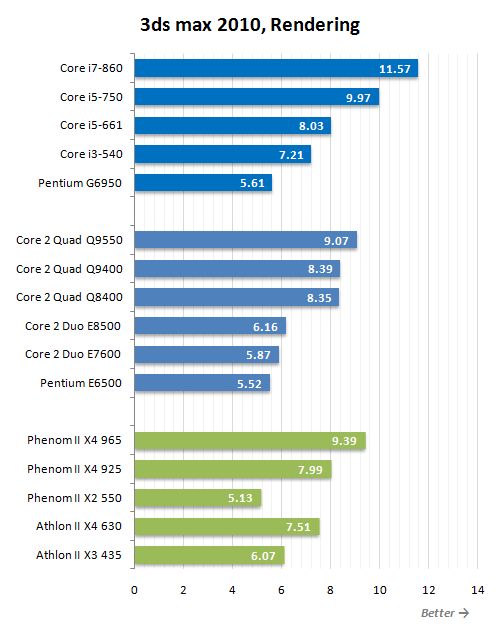
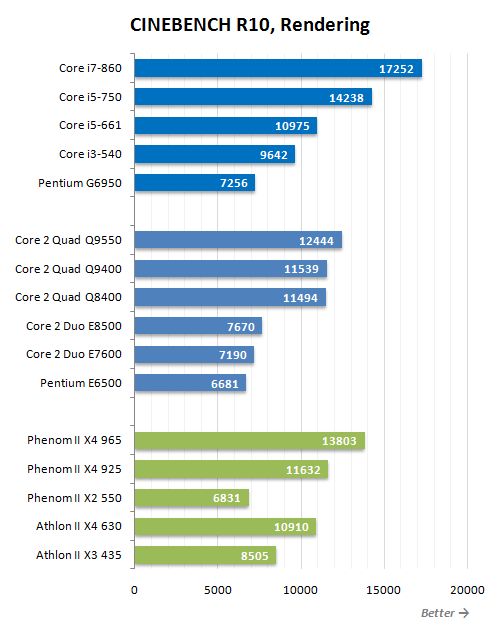
Just like video editing, rendering also belongs to well-paralleled tasks. Therefore, we see pretty much the same regularities. Dual-core Clarkdale processors supporting Hyper-Threading technology outperform dual-core LGA775 CPUs but fall behind quad-core LGA775 ones. In other words, we have every right to say that Core i5 and Core i3 processors raise the dual-core platforms performance to a new level. And this level is so high that the participating Core i5-661 CPU proves capable of competing successfully against junior quad-core competitor solutions – AMD CPUs. However, the positive verdict about the Clarkdale family we have just expressed doesn’t stick to the Pentium G6950 processor. This solution is only a little faster than the junior dual-core LGA775 models that is why it looks like an ugly duckling against the background of its more successful fellows.
Other Applications
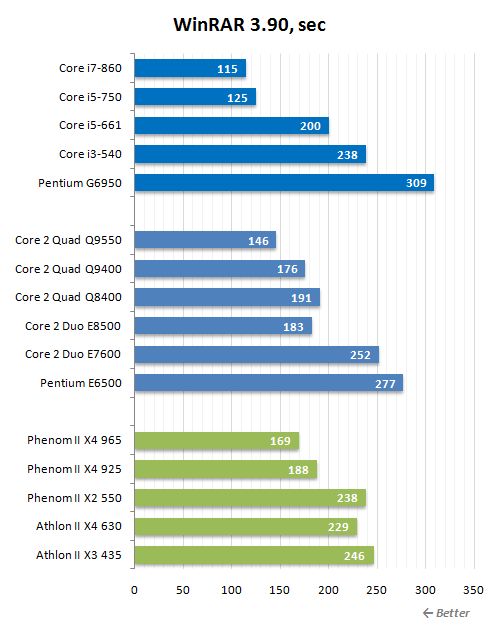
Here Clarkdale falls desperately behind Lynnfield. This is obviously the result of moving the memory controller into a separate semiconductor die. Therefore, you shouldn’t be surprised that Core i5-661 yielded to Core 2 Duo 8500. During data compression Core i5 and Core i3 work at about the same speed as dual-core LGA775 processors. As a result, Pentium G6950 turns out the slowest solution in this entire archiving test.
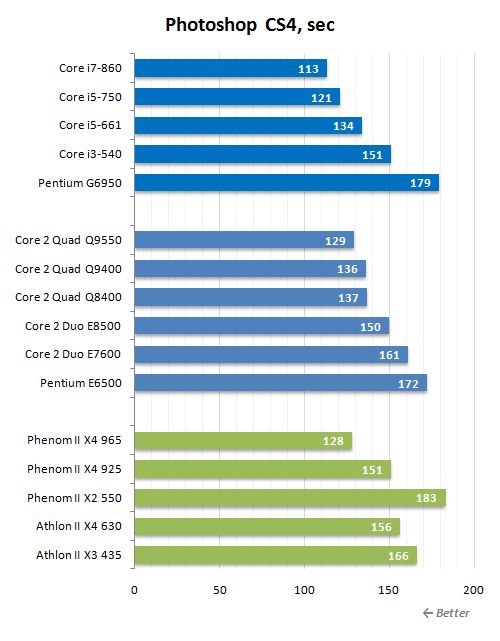
This time we gave up the traditional PSBench test to check out the image editing speed in Photoshop. Instead we prepared a new benchmark based on enhanced Retouch Artists Photoshop Speed Test including processing of four 10-megapixel images from a digital camera. Under a workload like that Core i5-661 can compete successfully against quad-core LGA775 and Socket AM3 solutions. Core i3-540 performs as good as the best dual-core CPUs, while Pentium G6950 loses hopelessly to the previous-generation dual-core Intel solutions.
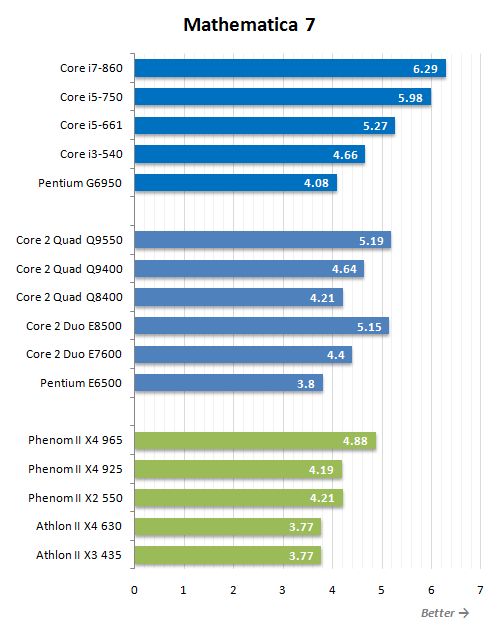
Multi-threading support is not implemented the best way in Mathematica 7 (within a single kernel). Therefore, a standard benchmark sorts out our testing participants in a not very standard way. Nevertheless, different Clarkdale CPUs perform quite up to the mark raising the performance bar in each price range.
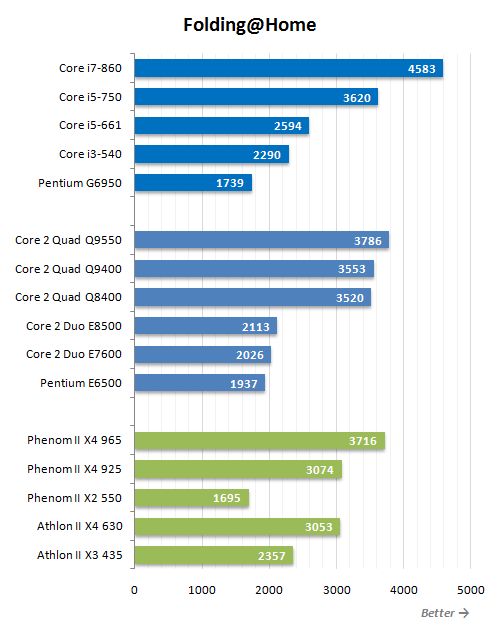
In the Folding@Home distributed computing suite Core i5-661 is just a little behind the quad-core CPUs. However, just like Core i3-540, it is undoubtedly faster than all dual-core processors, which is yet another proof of how beneficial Hyper-Threading support could be.
Power Consumption
One of the most intriguing characteristics of the new Clarkdale processors is their heat dissipation. They are manufactured partially using 32 nm process, which should affect the practical heat dissipation. On the other hand, the calculated thermal design power claimed by the manufacturer is 73 W. and even though it is 22 W lower than the calculated thermal design power of Lynnfield processors, it is still higher than the TDP of Core 2 Duo CPUs featuring heat dissipation of only 65 W. That is why it is totally unclear what the situation looks like in reality: can we build an energy-efficient system with a Clarkdale CPU or dual-core processors on Core microarchitecture will still offer better performance per watt ratio.
Therefore we tested the actual power consumption of all systems participating in our today’s test session. The following numbers show the total power consumption of the tested platforms (without the monitor). During our tests we used 64-bit LinX 0.6.3 utility to load the systems to the utmost extent. Moreover, to ensure that we estimate the power consumption in idle mode correctly we activated all power-saving technologies, such as C1E, Cool’nQuiet 3.0 and Enhanced Intel SpeedStep.
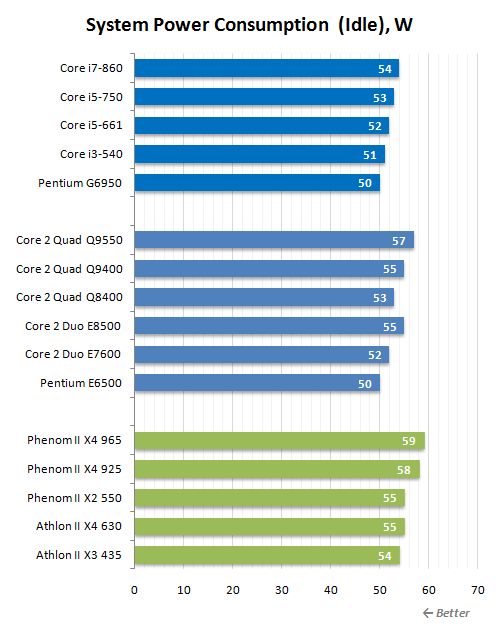
In idle mode the power consumption of LGA1156 platform with a Clarkdale processor inside looks quite good. In this case it appears even more economical than an LGA775 platform. By the way, note that the total power consumption of fully-functional performance platforms is only a little over 50 W. We owe this not only to contemporary processors supporting efficient power-saving technologies but also to Radeon HD 5870 graphics card that is several times more energy-efficient than its predecessors in 2D modes.
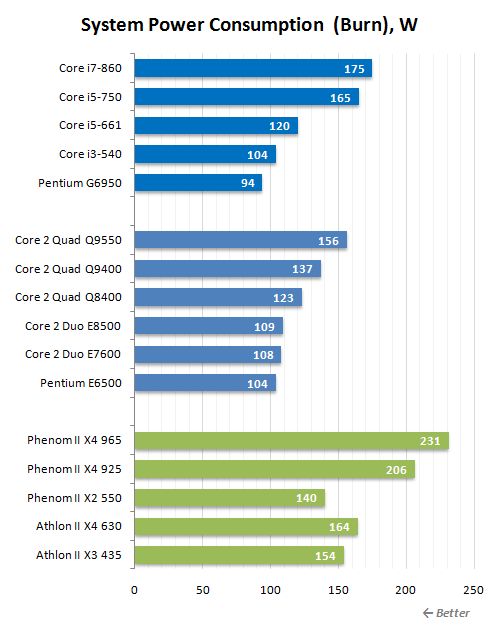
Under heavy load the situation is exactly the same as we would expect it to be judging by the official TDP numbers. Core i5 and Core i3 based systems consume much more than systems with dual-core LGA775 solutions. However, their power consumption is not any higher than that of systems with quad-core CPUs. Pentium G6950 stands out a bit here, as it suddenly appeared even more energy-efficient than Pentium E6500 for LGA775 systems. Overall, we can conclude that power consumption of the ne processors correlates pretty nicely with their performance. Yes, they do consume more power than the previous generation dual-core CPUs, but their performance has increased dramatically.
To get a better picture of the situation we also tested the power consumption of our testing participants under heavy load without taking into account the rest of the system components. To be more exact, we measured the power consumption along the 12 V power line connected directly to the processor voltage regulator on the mainboard and along the mainboard power lines.
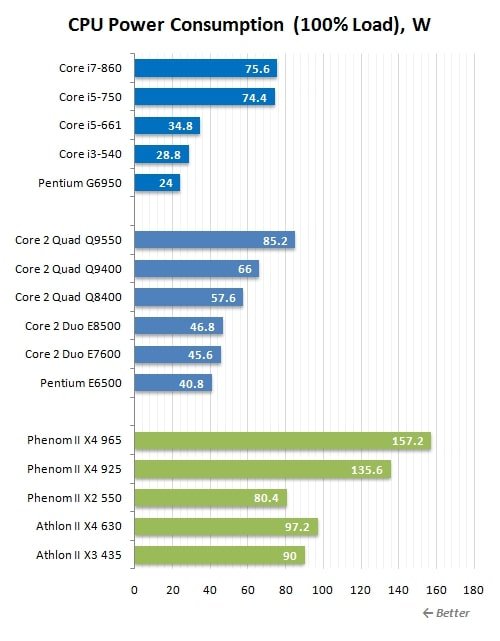
We are extremely surprised with the low power consumption readings taken off Clarkdale processors. However, the results can be explained easily. The thing is that the power from the individual 8-pin 12 V mainboard connector is sent only to the 32 nm processor die. The second 45 nm semiconductor die is powered by the mainboard. Therefore, we are also going to share the power consumption readings of the mainboards taken through their 24-pin ATX connectors.
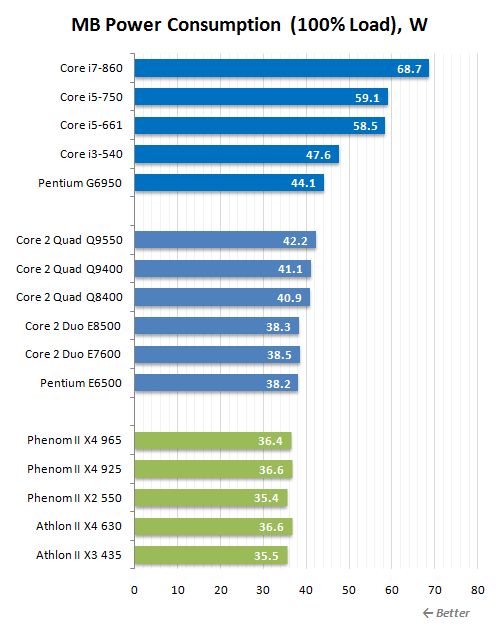
Now everything seems to be in the right place. These extremely low power consumption readings taken off the 8-pin power connector on LGA1156 platforms are totally compensated by the high power consumption of the mainboard.
Overclocking
The use of 32 nm process for manufacturing of the Clarkdale processor die makes them a very interesting solution for overclocking experiments. We hope the new core will be able to please overclocking fans with extended frequency potential, and its 45 nm addition represented by the GPU and North Bridge won’t become an obstacle.
We overclocked all three Clarkdale processors: Core i5-661, Core i3-540 and Pentium G6950. The tests were performed in a platform based on ASUS P7P55D Premium mainboard. We used Thermalright MUX-120 cooler (with traditionally bent base plate) for all three. It was topped with Enermax Magma UCMA12 fan (1500 RPM). System stability was tested using LinX 0.6.3 utility.
There is only one way to overclock LGA1156 processors: by raising the BCLK clock generator frequency. It is also true for Clarkdale, which is overclocked the same way as Lynnfield processors. Note that the presence of an integrated graphics core doesn’t make overclocking any harder, because it is clocked independently. However, the memory frequency increases proportionally to BCLK clock that is why during overclocking you have to keep an eye on it and correct the corresponding multiplier if necessary.
We didn’t intend to squeeze all the juices out of our CPUs during these overclocking experiments. Therefore, we didn’t increase the CPU Vcore by more than 0.15 V above the nominal. Turbo Boost technology was disabled when we increased BCLK clock.
As a result, Core i5-661 processor with the default frequency of 3.33 GHz and 1.16875 V nominal core voltage overclocked to 4.4 GHz.
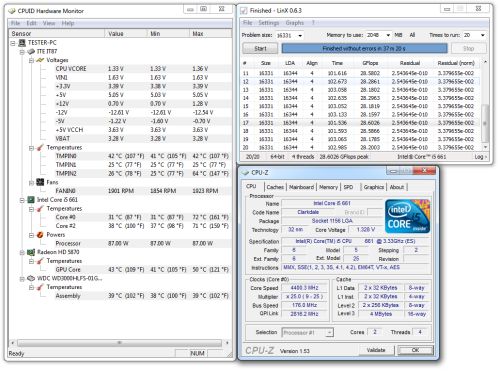
With Vcore increased to 1.328 V the CPU passed our stability tests OK. Its maximum temperature during these tests didn’t exceed 72 °C according to the integrated on-die thermal diodes.
The second Clarkdale Core i3-540 has the official nominal frequency of 3.06 GHz. Our sample had nominal core voltage of 1.18125 V.
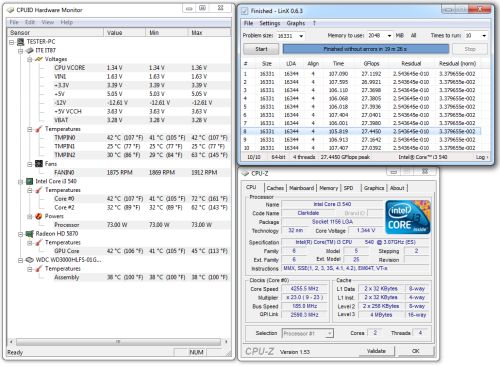
It overclocked a little worse. This CPU remained stable at 4.25 GHz maximum. In this case its Vcore equaled 31.344 V. The thermal readings during these stability tests again turned out OK: the CPU didn’t heat up more than 72 °C.
Pentium G6950 processor is the hardest one to overclock. Its nominal clock speed is 2.8 GHz, which means that we will have to push BCLK frequency very high up to hit 4.0 GHz or higher, and not all the mainboards can actually allow it. However, it didn’t prevent us from achieving very promising results during our overclocking experiments.
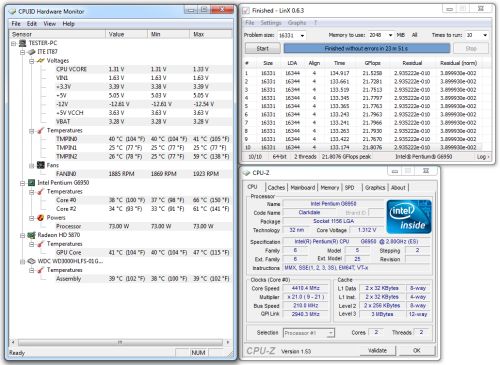
When we increased the core voltage of the test Pentium G6950 processor to 1.328 V, we managed to get it to work stably at 4.4 GHz frequency. BCLK in this case reached 210 MHz, but we didn’t experience any issues after raising the voltage of the North bridge part integrated into the processor from 1.1 V to 1.3 V. I have to say that the absence of Hyper-Threading support in Pentium G6950 has a positive effect on its thermal mode. During overclocking it didn’t heat up more than 66°C, according to the built-in thermal diode.
As we have expected, 32 nm technology used for Clarkdale manufacturing allows overclocking these processors better than Lynnfield. However, 45 nm dual-core Wolfdale CPUs on Core microarchitecture can sometimes overclock even higher with similar cooling. However, those overclockers who search for higher performance should go for Clarkdale, because these processors on Nehalem/Westmere microarchitecture can boast higher performance and will eventually be a faster choice.
Conclusion
Most Clarkdale reviews that you will see today online will most likely be full of the most flattering conclusions and will be convincing you that it is an excellent CPU. It is hard to argue that it is not the case, but we seem to have our own “special” opinion about it. We believe that Clarkdale is a very disappointing solution because it nothing like what we would expect a dual-core processor on Nehalem/Westmere microarchitecture to be. To really become an excellent solution that has inherited all the strengths of Nehalem microarchitecture, Clarkdale would have to be based on a monolithic semiconductor die manufactured with 32 nm process. However, Intel engineers had to compromise for the sake of lowering the production costs, which resulted in Clarkdale being split into two semiconductor dies, one of which is made using old manufacturing process. As a result, Clarkdale processors dissipate more heat than dual-core Core 2 Duo solutions. However, it is worse that some important functional units, including DDR3 SDRAM controller, got “separated” from the CPU, which led to slowing down of memory operations.
However, we will have to wait for at least another 1.5-2 years before our dreams find their way into hardware. This is when Intel should release their dual-core Sandy Bridge processor generation. That is why let’s sum up everything we know about the “limited” Clarkdale processor, which is available to us today. Despite its drawbacks, it turned out a very worthy product, from consumer point of view. Slow memory controller didn’t affect its performance too badly. Large 4 MB L3 cache partially makes up for this drawback. Besides, all other advantages of Nehalem microarchitecture are still in place.
As a result, Core i5-600 and Core i3-500 processors perform pretty fast and easily leave behind previous-generation dual-core solutions. Core i5-600 can even compete successfully against top quad-core CPUs for LGA775 platform. Hyper-Threading technology obviously turned out a very beneficial feature for dual-core Clarkdale. Since more and more applications get optimized for multi-core configurations, this particular technology allows new processors to hit the performance level that until recently used to be the prerogative of quad-core CPUs. By the way, it is the absence of Hyper-Threading support that determined the poor results of today’s third newcomer, Pentium G series, which was running very close to LGA775 Pentium solutions.
Besides pretty high performance for the mainstream market segment, new Core i5-600 and Core i3-500 processors boast pretty acceptable heat dissipation and power consumption. They are almost as energy-efficient as dual-core LGA775 CPUs, but the performance gain they provide is high enough to disregard the 10 watt increase in their thermal and energy parameters.
The new manufacturing process used for one of the two semiconductor dies inside Clarkdale processor, turned out great news for overclocking fans. The frequencies these new processors can hit have been pushed far beyond 4 GHz bar, which will most likely make Core i5 and Core i3 very popular among overclockers and enthusiasts.
Summing up everything we have just said, we can only state that the launch of new LGA1156 processors has significantly expanded the application field for this platform. It became a truly mainstream and universal platform, because now there are almost any kinds of LGA1156 processors available: starting with the cheapest ones and finishing with the most expensive solutions. And in all these price segments LGA1156 systems offer the today’s best combinations of consumer qualities. There is only one exception here. Unfortunately, LGA1156 mainboards have limited connectivity when it comes with multi-GPU configurations. The only way you can use two graphics cards in SLI or CrossFireX mode is by connecting them as PCI Express 8x + 8x. Triple and quad configurations are simply impossible on LGA1156 platforms at all. Therefore, LGA1366 platforms still remains very popular among the most dedicated gamers and enthusiasts who search for extreme performance at any rate.